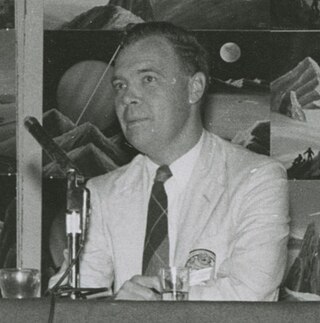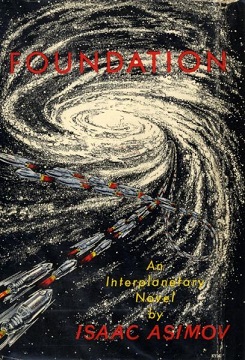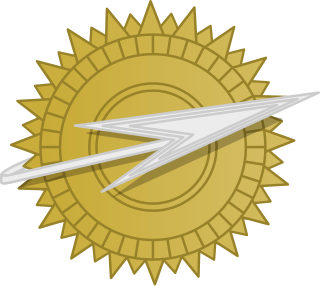Related Research Articles

Harry Clement Stubbs, better known by the pen name Hal Clement, was an American science fiction writer and a leader of the hard science fiction subgenre. He also painted astronomically oriented artworks under the name George Richard.

Isaac Asimov was an American writer and professor of biochemistry at Boston University. During his lifetime, Asimov was considered one of the "Big Three" science fiction writers, along with Robert A. Heinlein and Arthur C. Clarke. A prolific writer, he wrote or edited more than 500 books. He also wrote an estimated 90,000 letters and postcards. Best known for his hard science fiction, Asimov also wrote mysteries and fantasy, as well as popular science and other non-fiction.

The Foundation series is a science fiction book series written by American author Isaac Asimov. First published as a series of short stories and novellas in 1942–50, and subsequently in three collections in 1951–53, for nearly thirty years the series was a trilogy: Foundation (1951); Foundation and Empire (1952); and Second Foundation (1953). It won the one-time Hugo Award for "Best All-Time Series" in 1966. Asimov later added new volumes, with two sequels: Foundation's Edge (1982) and Foundation and Earth (1986), and two prequels: Prelude to Foundation (1988) and Forward the Foundation (1993).

The Three Laws of Robotics are a set of rules devised by science fiction author Isaac Asimov, which were to be followed by robots in several of his stories. The rules were introduced in his 1942 short story "Runaround", although similar restrictions had been implied in earlier stories.

Gardner Raymond Dozois was an American science fiction author and editor. He was the founding editor of The Year's Best Science Fiction anthologies (1984–2018) and was editor of Asimov's Science Fiction magazine (1986–2004), garnering multiple Hugo and Locus Awards for those works almost every year. He also won the Nebula Award for Best Short Story twice. He was inducted to the Science Fiction Hall of Fame on June 25, 2011.
A positronic brain is a fictional technological device, originally conceived by science fiction writer Isaac Asimov. It functions as a central processing unit (CPU) for robots, and, in some unspecified way, provides them with a form of consciousness recognizable to humans. When Asimov wrote his first robot stories in 1939 and 1940, the positron was a newly discovered particle, and so the buzz word "positronic" added a scientific connotation to the concept. Asimov's 1942 short story "Runaround" elaborates his fictional Three Laws of Robotics, which are ingrained in the positronic brains of nearly all of his robots.

Asimov's Science Fiction is an American science fiction magazine edited by Sheila Williams and published by Dell Magazines, which is owned by Penny Press. It was launched as a quarterly by Davis Publications in 1977, after obtaining Isaac Asimov's consent for the use of his name. It was originally titled Isaac Asimov's Science Fiction Magazine, and was quickly successful, reaching a circulation of over 100,000 within a year, and switching to monthly publication within a couple of years. George H. Scithers, the first editor, published many new writers who went on to be successful in the genre. Scithers favored traditional stories without sex or obscenity; along with frequent humorous stories, this gave Asimov's a reputation for printing juvenile fiction, despite its success. Asimov was not part of the editorial team, but wrote editorials for the magazine.

Drexel Jerome Lewis Bixby was an American short story writer and scriptwriter. He wrote the 1953 story "It's a Good Life", which was included in The Science Fiction Hall of Fame. It formed the basis of a 1961 episode of The Twilight Zone and was remade in Twilight Zone: The Movie (1983). He wrote four episodes for the Star Trek series: "Mirror, Mirror", "Day of the Dove", "Requiem for Methuselah", and "By Any Other Name". With Otto Klement, he co-wrote the story upon which the science fiction movie Fantastic Voyage (1966), the related television series, and the related Isaac Asimov novel were based. Bixby's final produced or published work so far was the screenplay for the 2007 science fiction film The Man from Earth.

The Galactic Empire is an interstellar empire featured in Isaac Asimov's Robot, Galactic Empire, and Foundation series. The Empire is spread across the Milky Way galaxy and consists of almost 25 million planets settled exclusively by humans. For over 12 millennia the seat of imperial authority was located on the ecumenopolis of Trantor, whose population exceeded 40 billion, until it was sacked in the year 12,328. The official symbol of the empire is the Spaceship-and-Sun. Cleon II was the last Emperor to hold significant authority. The fall of the empire, modelled on the fall of the Roman Empire, is the subject of many of Asimov's novels.
This is a bibliography of the books written or edited by Isaac Asimov, arranged alphabetically. Asimov was a prolific author, and he engaged in many collaborations with other authors. This list may not yet be complete. The total number of books listed here is over 500. Asimov died in 1992 at age 72; a small number of his books were published posthumously.

"The Last Question" is a science fiction short story by American writer Isaac Asimov. It first appeared in the November 1956 issue of Science Fiction Quarterly and in the anthologies in the collections Nine Tomorrows (1959), The Best of Isaac Asimov (1973), Robot Dreams (1986), The Best Science Fiction of Isaac Asimov (1986), the retrospective Opus 100 (1969), and in Isaac Asimov: The Complete Stories, Vol. 1 (1990). While he also considered it one of his best works, "The Last Question" was Asimov's favorite short story of his own authorship, and is one of a loosely connected series of stories concerning a fictional computer called Multivac. Through successive generations, humanity questions Multivac on the subject of entropy.

Quasar, Quasar, Burning Bright is a collection of seventeen scientific essays by American writer and scientist Isaac Asimov. It was the thirteenth of a series of books collecting essays from The Magazine of Fantasy and Science Fiction. These essays were first published between May 1976 and September 1977. It was first published by Doubleday & Company in 1978. Its title is derived from the first line of William Blake's 1794 poem "The Tyger".
Niven's laws were named after science fiction author Larry Niven, who has periodically published them as "how the Universe works" as far as he can tell. These were most recently rewritten on January 29, 2002. Among the rules are:
There have been many attempts at defining science fiction. This is a list of definitions that have been offered by authors, editors, critics and fans over the years since science fiction became a genre. Definitions of related terms such as "science fantasy", "speculative fiction", and "fabulation" are included where they are intended as definitions of aspects of science fiction or because they illuminate related definitions—see e.g. Robert Scholes's definitions of "fabulation" and "structural fabulation" below. Some definitions of sub-types of science fiction are included, too; for example see David Ketterer's definition of "philosophically-oriented science fiction". In addition, some definitions are included that define, for example, a science fiction story, rather than science fiction itself, since these also illuminate an underlying definition of science fiction.

Sir Arthur Charles Clarke was an English science fiction writer, science writer, futurist, inventor, undersea explorer, and television series host.

The Eternity Artifact is a science fiction novel by American writer L. E. Modesitt, Jr., published in 2005. It is set in a future approximately 3,000 years hence, in a galaxy largely colonized by humans but divided into disparate polities who strive against each other in a manner similar to that of modern-day nations. Once such group, the Comity, discovers a planet that may be the first evidence of nonhuman intelligent life. The Comity mounts an expedition to investigate this world, and certain of the other groups attempt to interfere in various ways and for various reasons. The story discusses the expedition from the perspective of four viewpoint characters. It details the progress of the explorers and touches on the differences between the various human groups and how those inform their response to this discovery, and their goals regarding it.
Parkinson's law is the observation that the duration of tasks within a public administration, bureaucracy or officialdom expand to fill their allotted time spans, regardless of the amount of work to be done. This was attributed mainly to two factors: that officials want subordinates, not rivals, and that officials make work for each other.
This is a bibliography of American science fiction author Kim Stanley Robinson.

Nebula Awards 27 is an anthology of science fiction short works edited by James Morrow, the second of three successive volumes under his editorship. It was first published in hardcover and trade paperback by Harcourt Brace in April 1993.
Depending on the counting convention used, and including all titles, charts, and edited collections, there may be currently over 500 books in Isaac Asimov's bibliography—as well as his individual short stories, individual essays, and criticism. For his 100th, 200th, and 300th books, Asimov published Opus 100 (1969), Opus 200 (1979), and Opus 300 (1984), celebrating his writing.
References
- ↑ Beech, Martin (2012). The Physics of Invisibility: A Story of Light and Deception . New York: Springer Science + Business Media. p. 190. ISBN 978-1-46140615-0.
- ↑ Keyes, Ralph (2006). The Quote Verifier: Who Said What, Where, and When. New York: St. Martin's Press. p. 217. ISBN 978-0-31234004-9.
- ↑ "Hazards of Prophecy: The Failure of Imagination" in the collection Profiles of the Future: An Enquiry into the Limits of the Possible (1962, rev. 1973), pp. 14, 21, 36.
- ↑ Shermer, Michael (2011). The Believing Brain: From Ghosts and Gods to Politics and Conspiracies — How We Construct Beliefs and Reinforce Them as Truths. New York: Henry Holt & Co. p. 358. ISBN 978-0-80509125-0.
- ↑ Clarke, Arthur C. (19 January 1968). "Clarke's Third Law on UFO's". Science. 159 (3812): 255. Bibcode:1968Sci...159..255C. doi:10.1126/science.159.3812.255-b. ISSN 0036-8075. S2CID 159455247.
- ↑ Clarke, Arthur C. (1973). Profiles of the Future: An Inquiry into the Limits of the Possible. Popular Library. ISBN 978-0-33023619-5.
- ↑ Asimov, Isaac (1952). Foundation and Empire. New York: Bantam Dell. p. 10. ISBN 0-553-29337-0.
- ↑ "The Sorcerer of Rhiannon", Astounding February 1942, p. 39.
- 1 2 3 Gooden, Philip (2015). Skyscrapers, Hemlines and the Eddie Murphy Rule: Life's Hidden Laws, Rules and Theories. Bloomsbury Publishing. p. 83. ISBN 978-1-47291503-0.
- ↑ Shermer, Michael (January 2002). "Shermer's Last Law" . Scientific American .
- ↑ Rubin, Charles T. (5 November 2008). "What is the Good of Transhumanism?". In Chadwick, Ruth; Gordijn, Bert (eds.). Medical Enhancement and Posthumanity (PDF). Springer. p. 149. ISBN 978-904818005-9. Archived (PDF) from the original on 16 October 2014. Retrieved 17 October 2014. Rubin is referring to an earlier work of his:
Rubin, Charles T. (1996). "First contact: Copernican moment or nine day's wonder?". In Kingsley, Stuart A.; Lemarchand, Guillermo A. (eds.). The Search for Extraterrestrial Intelligence (SETI) in the Optical Spectrum II: 31 January – 1 February 1996, San Jose, California, Band 2704. Proceedings of SPIE – the International Society for Optical Engineering. Bellingham, WA: SPIE—The International Society for Optical Engineering. pp. 161–84. ISBN 978-0-8194-2078-7. - ↑ John Brockman. "2004 : WHAT'S YOUR LAW?".
- ↑ "Asimov's Corollary" The Magazine of Fantasy and Science Fiction February 1977
- ↑ Leeper, Evelyn; Leeper, Mark (5 November 2004). "Correction". The MT Void. Vol. 23, no. 19. Mt. Holz Science Fiction Society. Archived from the original on 29 December 2004. Retrieved 29 November 2015.